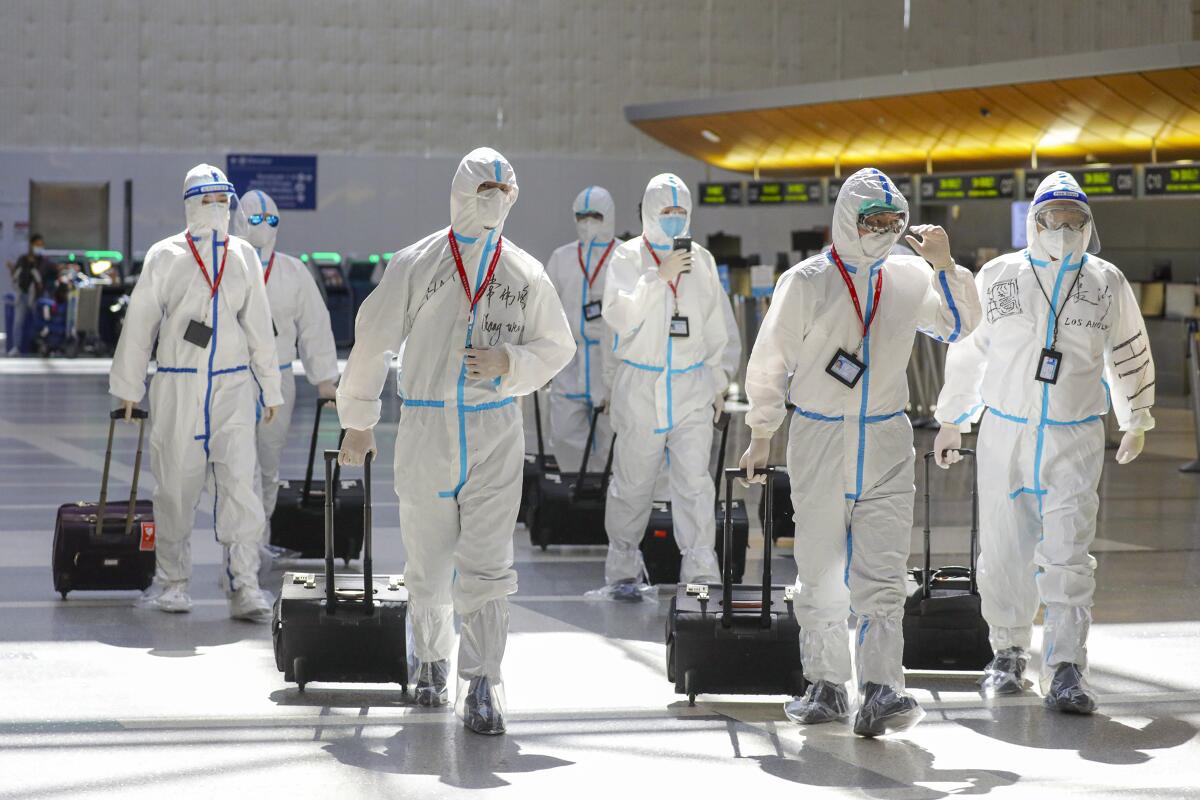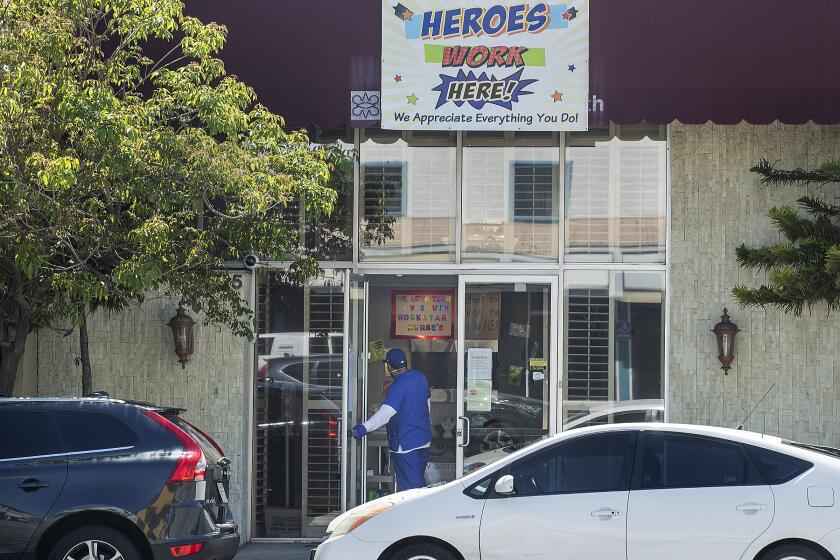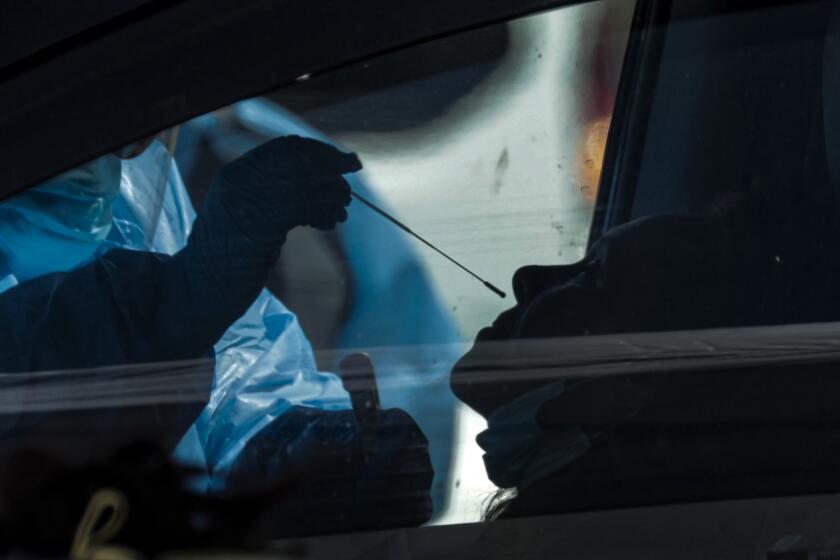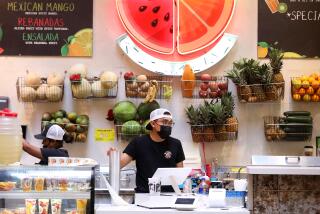Coronavirus ‘silent spreaders’ become a bigger risk as California reopens

The role of “silent spreaders” in transmitting the coronavirus is becoming an even greater issue for health officials as they ease stay-at-home rules and slowly reopen the economy.
Health officials have stressed the importance of creating an army of disease detectives — investigators who can interview newly infected people and find their close contacts, telling them to quarantine themselves for 14 days in hopes of keeping other people from getting infected.
But if many people who get the virus don’t show symptoms and yet are infectious, the disease could spread invisibly, beyond the reach of county health officials.
Health experts say it can take a few days from the time a person becomes infected, and could infect others, and the point at which they begin to show signs of illness. It’s called “presymptomatic transmission.” There’s also “asymptomatic transmission,” in which infected people show no serious signs of illness but still can spread the disease.
One of the biggest challenges in trying to contain the coronavirus is that an unknown number of people are spreading it when they don’t even seem sick themselves.
There’s increasing concern that silent spreaders are playing a large role in the transmission of COVID-19, which is becoming the greatest public health threat of the century. With a possible new surge in coronavirus cases in the fall, being able to find those people becomes more crucial.
Identifying silent spreaders also is important as California eases stay-at-home rules now, allowing people to eat inside restaurants, shop in stores, go to beaches and parks, and resume in-person church services.
All these activities come with strict social distancing rules designed to make it harder to spread the virus. But scientists and officials say that reopening brings new risks, especially when people who have the illness but show no symptoms are out and about.
The U.S. Centers for Disease Control and Prevention estimates there’s a 20%-to-50% chance that those infected with the coronavirus do not show symptoms. Yet even those asymptomatic people may be just as capable of transmitting the disease as other infected people who eventually become visibly sick, the CDC said.
That’s why it’s so important to adhere to social distancing and wearing masks, experts say.
“The best way to protect yourself — and to protect others in case you yourself were infected — is to treat it as though everyone is potentially infected,” said Dr. Robert Kim-Farley, medical epidemiologist and infectious disease expert at the UCLA Fielding School of Public Health. “Keep that social distancing. And keep that masking on.”
Kim-Farley said images of large numbers of people gathering closely together without masks is going to result in increased spread of the coronavirus. It can take two to four weeks before an accelerating rate of infections can be observed in worsening hospitalization numbers and a rising weekly death toll.
“Without having social distancing, we are going to definitely see some increased spikes and transmission occurring. That’s definitely going to happen,” said Kim-Farley, a former senior official with the L.A. County Department of Public Health, the CDC and World Health Organization.
Federal officials have echoed those warnings.
“We’ve made it clear that there’s asymptomatic spread, and that means that people are spreading the virus unknowingly. And this is unusual in the case of respiratory diseases ... so you don’t know who’s infected,” Dr. Deborah Birx, the White House’s coronavirus response coordinator, told ABC News on Sunday.
Of 402 residents and workers testing positive for the coronavirus at Los Angeles County nursing homes, 345 of them had no symptoms of illness, the director of public health, Barbara Ferrer, said last week. In other words, 86% of people testing positive at scores of skilled nursing facilities across the nation’s most populous counties had no symptoms of the disease when they were tested.
As deaths mount, LA County far behind on promise to test everyone in nursing homes.
This is not the only study to raise concerns about the large numbers of presymptomatic or asymptomatic infected people. A UC San Francisco study conducted in late April found that, among several thousand residents and workers in San Francisco’s Mission District, 62 people tested positive for COVID-19 — but more than half of them, 53%, had no symptoms at the time they were tested.
An editorial in the New England Journal of Medicine in late April called asymptomatic transmission of the coronavirus “the Achilles’ heel of COVID-19 pandemic control through the public health strategies we have currently deployed.”
“Live coronavirus,” the editorial said, “clearly sheds at high concentrations from the nasal cavity even before symptom development.”
In another study, also published in the New England Journal of Medicine, 56% of residents at a skilled nursing facility in Washington state’s King County who initially tested positive in a survey of patients showed no symptoms at the time, but most later did show signs of illness. It took a median of four days for them to show symptoms.
Visibly healthy people can also be omitted from other efforts aimed at trying to identify infected people, such as attempting to screen incoming airline passengers from overseas countries.
A study of COVID-19 patients and the people they likely infected suggests the coronavirus can spread for more than two days before symptoms appear.
And a silent spreader can transmit the coronavirus simply by talking. Loud talking can emit thousands of saliva droplets per second, and researchers recently found that, in a stagnant air environment, droplets of fluid sprayed from the mouth remained in the air for as long as eight to 14 minutes before drying up.
“These observations confirm that there is a substantial probability that normal speaking causes airborne virus transmission in confined environments,” said the authors in the study published in the Proceedings of the National Academy of Sciences on May 13.
Pre-symptomatic people have been identified as the index patient in a number of outbreaks.
In the southern Chinese city of Guangzhou, one person who had just returned from Wuhan — the epicenter of the global pandemic — was pre-symptomatic while eating lunch on Jan. 24 at a restaurant with family. Scientists concluded that person infected two other families sitting at neighboring tables about three feet away, according to a report published by the CDC. Scientists suspect that infected droplets from the index patient hitched a ride on air flows powered by an air-conditioning system.
In Singapore, pre-symptomatic tourists from Wuhan visited a church in Singapore on Jan. 19 and started showing symptoms several days later. Three other people who attended the same church on the same day also got sick, including one who sat in the same seat as the tourists, according to closed-circuit camera video documented in a CDC report. Officials did not uncover any symptomatic church attendees who visited that day.
It’s easier to suffocate a disease where the symptoms are obvious, and in which infectiousness occurs after symptoms show up, Kim-Farley said. For instance, there are very few asymptomatic cases of measles, and officials can identify cases, isolate them, find the infected person’s close contacts and quarantine them, snuffing out an outbreak.
But diseases where there’s a large share of asymptomatic cases can be far harder to deal with. For instance, for every 100 people who were infected with polio, only about one person fell ill with paralysis, Kim-Farley said. “So it’s highly asymptomatic. So that’s why you really can’t do contact tracing for polio, because for every case that you identify that has symptoms, there are 99 others that don’t. So it’s silently spread in the community.”
That’s why, in the years before the polio vaccine was available on a large scale in the mid-1950s, many parents kept their children at home, even in the summer when the spread of the virus seemed to peak. Polio was once one of the nation’s most feared diseases, crippling more than 35,000 people a year, on average.
There are some estimates that suggest the proportion of asymptomatic patients may be even higher than what the CDC has said publicly: Experts estimate that 25% to 75% of coronavirus infections may be asymptomatic, Kim-Farley said. If it’s on the higher end, even public health officials with robust disease-detective resources could fail to detect much of the spread of the disease
In such a situation, health officials should take aggressive measures to protect the most vulnerable, like those in nursing homes, until the number of new cases falls to essentially zero, Kim-Farley said.
Silent spread of the coronavirus is all the more reason to wear masks in public, Dr. George Rutherford, an epidemiology and infectious-disease expert at UC San Francisco, said Thursday in a campus webinar.
“What we’re really trying to do is prevent transmission from talking,” Rutherford said. “We’re trying to ... prevent people who are asymptomatically infected from transmitting.”
America learned the lesson of wearing masks a century earlier. In an unearthed photo showing fans at a Georgia Tech football game during the 1918 flu pandemic, most people are wearing masks.
“As you can see, everybody in the stands has on masks. So that’s what’s gonna help us out,” Rutherford said.
Face coverings not only help keep asymptomatic people from transmitting the virus to others, he said, but they also provide some protection to the wearer.
The White House’s Birx has emphasized the importance of masks, saying on ABC News, “Social distancing is absolutely critical. And if you can’t social distance and you’re outside, you must wear a mask. These are items that are really critical to protect individuals.”
She said it would also be important to proactively test asymptomatic people, such as residents and workers at nursing homes and workers at meatpacking plants and in agriculture. The coronavirus can spread rapidly in the right conditions.
“What I’m worried about is: What are we putting in place to find asymptomatic cases?” Birx said. “All of this proactive testing needs to be in place — and needs to continue to be in place — because that will determine safely remaining open in the fall.”
More to Read
Start your day right
Sign up for Essential California for news, features and recommendations from the L.A. Times and beyond in your inbox six days a week.
You may occasionally receive promotional content from the Los Angeles Times.









